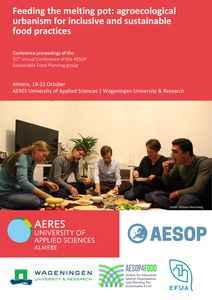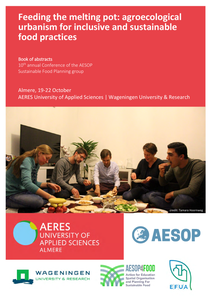This chapter explores the use of “responsive” or “interactive” urban media technologies as a tool or “building block” in the (re)design of urban public spaces. This is especially relevant as in the last two decades, urban development and digital technologies have brought out new types of urban typologies and practices often referred to as “networked urbanism.” These typologies and practices bring out specific challenges with regard to their functioning as public space. We argue that responsive technologies could reinforce qualities of public space in this condition of “networked urbanism”; however, their implementation demands new strategies and above all new forms of cooperation between disciplines such as architecture, urban design, and urban interaction design. To aid such an approach, this chapter introduces a heuristic of five mechanisms of responsive media. These are meant to function as a shared vocabulary aiding designers of various backgrounds to collaborate in an interdisciplinary design process for public spaces in a broader development of networked urbanism.
DOCUMENT
This book discusses the way that a nature-driven approach to urbanism can be applied at each of the urban scales; architectural design, urban design of neighborhoods, city planning and landscape architecture, and at the city and regional scales. At all levels nature-driven approaches to design and planning add to the quality of the built structure and furthermore to the quality of life experienced by people living in these environments. To include nature and greening to built structures is a good starting point and can add much value. The chapter authors have fiducia in giving nature a fundamental role as an integrated network in city design, or to make nature the entrance point of the design process, and base the design on the needs and qualities of nature itself. The highest existence of nature is a permanent ecosystem which endures stressors and circumstances for a prolonged period. In an urban context this is not always possible and temporality is an interesting concept explored when nature is not a permanent feature. The ecological contribution to the environment, and indirect dispersion of species, from a temporary location will, overall add biodiversity to the entire system.
LINK
This article discusses the question: where to with sustainable urbanism? It includes a historic review of the concept of sustainable urbanism and reviews of recent literature in the field of eco-cities. Through these reviews, it deliberately interrogates new pathways for sustainable urbanism. The result of this investigation is the insight that there are six design principles that are required to create a sustainable city: a design in which cycles are closed, redundancy is built in, anti-fragility is created, citizens are seen as (design) experts, the landscape is used as the basis, and innovative, rule-breaking designs are developed. These six design principles are then captured in three comprehensive concepts, which together support the design of a sustainable city: the design approach needs to be a (1) society-based; (2) complexity-led, and (3) landscape-driven design approach.
DOCUMENT
Current urban design and urban planning aim to facilitate global, regional and local urbanization programs. This implies most of the planning documents give room to the types of land use that seem to require space ‘here and now’. The amount of new housing, office and other industrial and commercial space, accompanying amounts of parking lots and the necessity of new transportation routes, infrastructure and corridors are the main topics in the majority of future oriented plans. This is what is called ‘fast urbanism’ ((Roggema, R., Special Issue Urban Planning 6:946-956, October 2015)). It is the natural preferred habit of planners, decision-makers and politicians, and many developers, economists and municipal land departments. It seems as if this way of future planning brings the highest revenues, and this may be true, on the short term and for only a limited part of involved groups in the city. The impact of this way of planning the city has negative consequences for our health in general (see Roggema, this volume, Chap. 5; Han and Keeffe, this volume, Chap. 4; Monti, this volume, Chap. 11), and more specifically the quality of nature and biodiversity in our urban and natural environments (Birtles, this volume, Chap. 10; Tillie, this volume, Chap. 6; Monti, this volume, Chap. 11; Backes et al., this volume, Chap. 3; Sijmons, this volume, Chap. 2). One way of coping with the effects is to ‘repair’ the damage after the city has been built. Aiming to increase the quality of small green spaces (Veldman, this volume, Chap. 13; Casagrande, this volume, Chap. 7), add temporary nature (Backes et al., this volume, Chap. 3), or greening buildings (Bosse, this volume, Chap. 15), could help to prevent the largest impacts of fast urbanism. However, this will always be a solution that repairs, or greenwashes urbanization that has neglected the natural systems in the first place
LINK
The surge of smart city technology, thinking, publications and consultancy offerings is significant. This implies there is something seriously developing. But to what extent is this a new development? In this paper the case will be made that urban design has always had to include new technologies and the smart city movement is just another wave of technology that demands inclusion in urban design practice. Nevertheless, city designers and policy makers should make use of the new possibilities on offering. Interactive urban environments could support healthy living, while smart and responsive regulators could minimize our energy use, and anticipative traffic management could help minimising congestion. Further to this, crowd-sensing could smoothen urban mobility and new forms of 3d-printing may re-use and reduce waste. The core of all new technological potential however is still to service people and to make life for urban citizens better. How could people in search for a convenient life be better serviced? Many of them want to have a nice house, a clean, safe and healthy environment, access to resources such as clean water, renewable energy and healthy food, a resilient place that is not vulnerable for all kinds of climate impacts and possibly some room for contemplation. With Maslow’s ladder in mind, achieving this not only depends on the availability and use of technology, rather a well-designed and integrated urban plan is asked for. Meeting the needs of contemporary urban citizens must be served by what urban design is supposed to deliver, only now with current available technologies in the back pocket. The paper emphasises how to design the convenient city by making use of the available technology, but it also takes a stand on the relativity of the current hype of smart cities.
DOCUMENT
In this chapter we move back in time, to when it was not an usance to base our city designs on the natural systems of water and ecology. By the end of the 1980s the dogma of separation of functions, and dividing the city in areas for working, living, leisure and traffic was slowly abandoned and especially the focus on the traffic system, more in particular the car, was leading to uproar. In this timeframe an alternative to apply the principles of nature in urban design was very new and, in the beginning, needed to be conquered on the traditionalists who would pertain using their old-school design standards. In this chapter the development story of Westerpark, and Heilaar-Steenakker is presented. This area in the western outskirts of the city of Breda, in the south of the Netherlands, was one of the first, maybe even the first to use knowledge about the water system, ecological typologies and nature as the basis for urban planning. This article starts with a description in sections two and three of the policy context at national level to illustrate the momentum of change from rationalism towards ecological planning. In section four the policy context in Breda in the early nineties is presented as the context within which the planning of Heilaar-Steenakker (Sect. 8.5) and Westerpark (Sect. 8.6) could be based in a strong sense of the natural processes of ecology and water that formed the landscape in history.
LINK
These conference proceedings to the 10th annual conference of the AESOP Sustainable Food Planning group are organised as follows: the following four sections contain the short papers belonging to the four tracks that made up the conference (social inclusion; urban agriculture; urban planning, design and development; food governance). The last section consists of the abstracts of the book and poster presentations, a short report on the YAP workshop held at the first day of the conference, and a short report on the excursion organised at the last conference day.
DOCUMENT

Short clip as result of research week FreshBrains Bonn.
LINK

This book contains the abstracts to the sessions presented at the AESOP Sustainable Food Planning conference in 2022. The conference was made up of four tracks: social inclusion; urban agriculture; urban planning, design and development; food governance.
DOCUMENT
